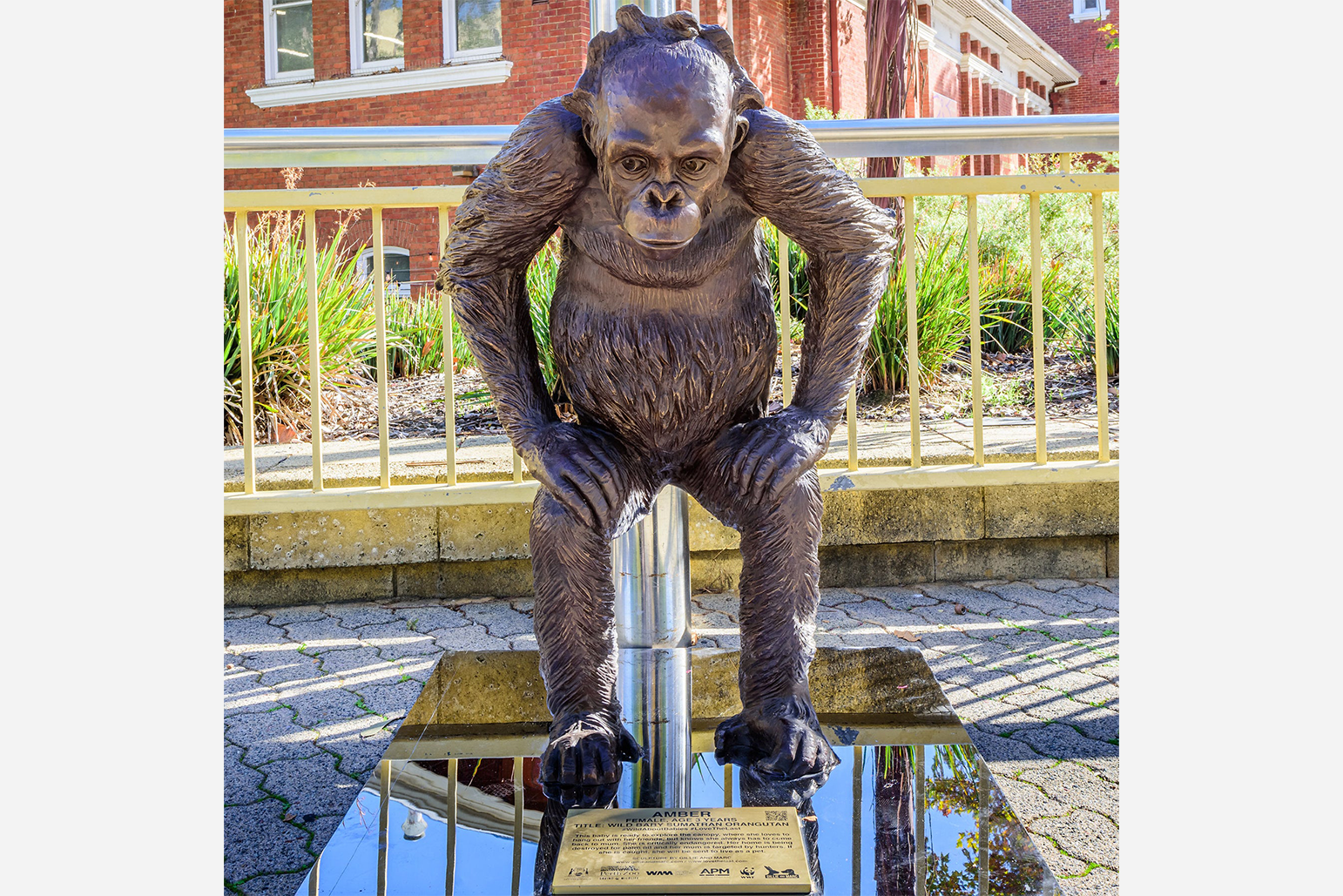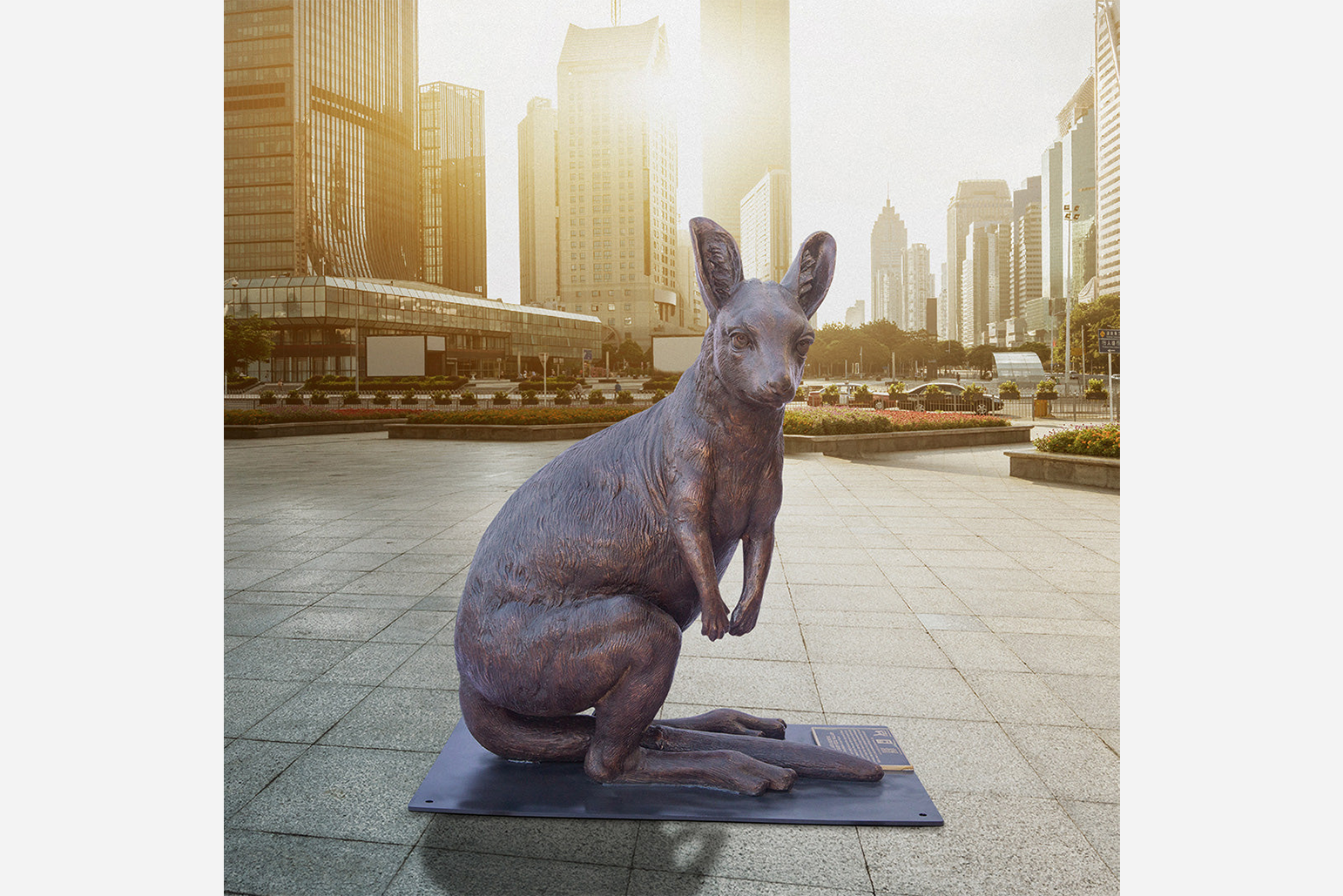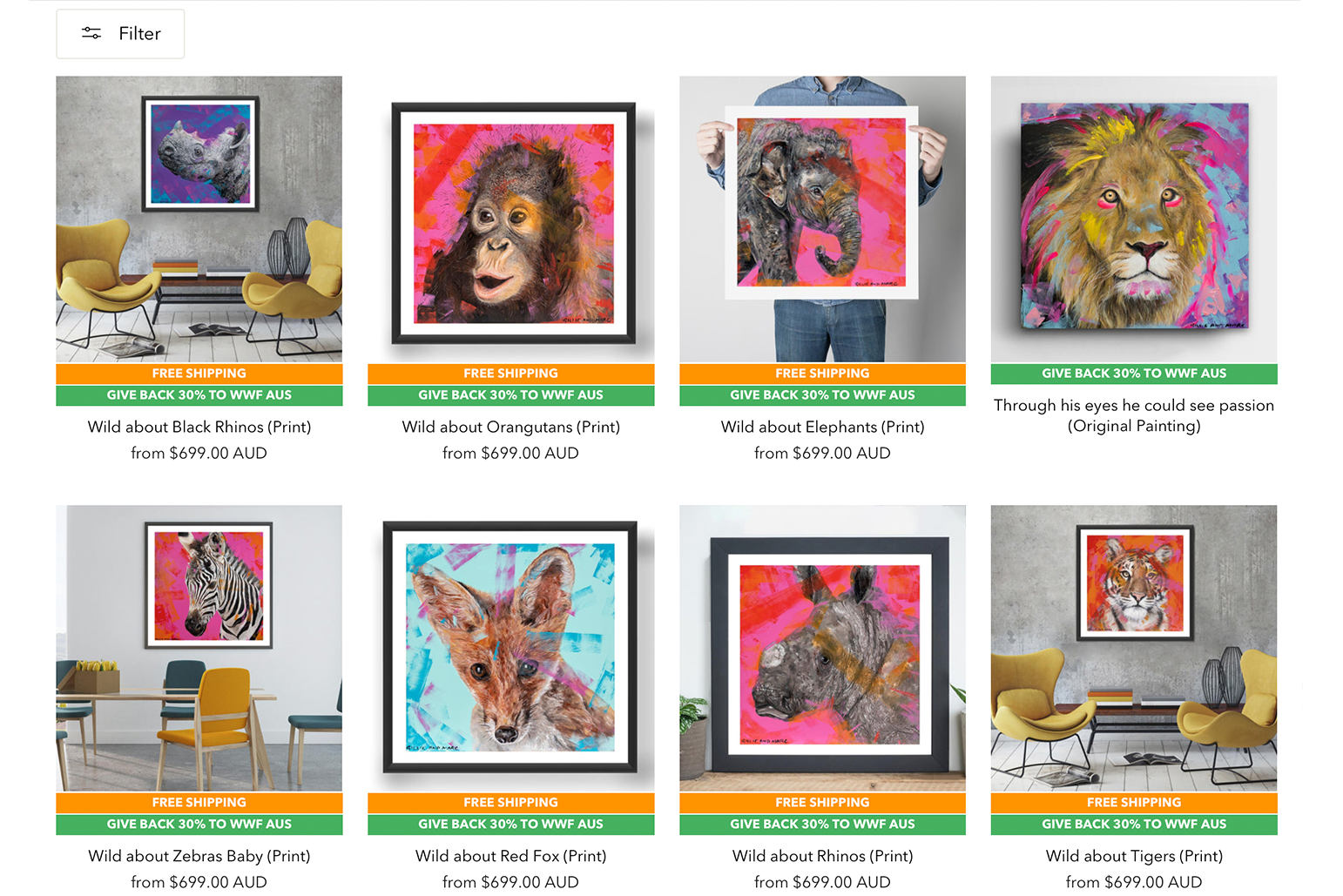


They lurk among us: around the State Library, by Picabar, nearby the State Gallery, and across the Museum. They are a gang of twenty bronze baby animal sculptures that have descended on the “Perth Cultural Centre”. The latest project of Sydney duo Gillie and Marc in WA, Wild About Babies is billed as “one of the world's largest public sculpture projects” and is supported by the WA Government, World Wide Fund for Nature (WWF), employment services provider APM, WA Museum Boola Bardip, Perth Zoo, and Perth Cultural Precinct. Peppered around the precinct, the twenty bronzes depict the “most adorable yet endangered animals”. On Gillie and Marc’s website, the PR for Wild About Babies claims that:
Presumably, appreciation follows love and the spark is lit for this generation to begin ‘changing the course of mass extinction’—all thanks to this collection of bronze sculptures. Yet, surely someone, in some meeting, must have asked whether casting endangered species in alloy might be incongruent with the premise of environmentalism. Casting bronzes “for the environment” seems cynical, disingenuous, and thoughtless, if not outright unethical.
Admittedly, Gillie and Marc are low-hanging fruit for the art critic; both popular and easy to hate. Twitter freak and art critic Jerry Saltz has posted many memorable Tweets about Gillie and Marc, who, as ex-marketers, carefully respond with on-brand schtick.
For Wild About Babies, Gillie and Marc appear to be even more outside their comfort zone—one need only look at the misproportioned monstrosities strewn around the “Cultural Centre”. The scale and forms of the sculptures are, at best, awkward, clunky, uneasy, even lifeless; at times, they are uncannily similar in design to the wild animal figurines manufactured by toy company Schleich. Just look at the baby Sumatran orangutan sculpture, suspended mid-squat, perched in, what appears to be, perpetual defecation. Or the baby African elephant located near Boola Bardip and the State Library, frozen in a fawning position, as if a classical reclining nude, primed for ridicule rather than anthropomorphic admiration. Perhaps the largest blindspot in the project is the lack of endangered native Australian fauna, bar one uncomfortable-looking baby rock wallaby.
The pair have been producing public eyesores for years, most notably in New York, as well as in Melbourne, Sydney, Singapore, Beijing, and anywhere else that will have them. Up until now, WA had only suffered thrice at the hands of Gillie and Marc: the poor folks of Jandakot are subjected to Table of Love, a nauseating sculpture of a dinner date between a humanoid hare and hound; Paparazzi Pack, a group of the duo’s signature “dog-man” bronzes, fitted with suits and DSLRs, ready to pap the celebs of Onslow; and the Tandem Riders of Beaufort Street, which sees the return of our dog and rabbit lovers, cycling nude up the street—one must presume their date in Jandakot was successful!
Looking further into their work, I visit the duo’s website. There, I find the most nauseating paintings I have seen. Included are such “works” as Life was all ok (‘originally $6,100, now $3,050, save $3,050!’), Today was perfect, and They said ha ha (both also now half-price!). These three paintings depict “dogman” and “rabbitwoman” quite obviously entangled in a whirlwind love affair, riding together on a vespa, perhaps off to a villa to consummate their marriage—it’s best not to dwell. Behind the stencilled figures is an array of abstract splotches of paint. I use the word “abstract” generously. Each is simply a mess of colour painted without aptitude or care, with the single intention to “fill in the blank” of the canvas. Scrolling the website, I notice one description which reads:
Gripping stuff. Looking at the pair’s paintings and website reveals (if it was not already painfully obvious) the excessive, excruciating commerciality of the work.
One of the trending results of Google searching ‘bad public art in Australia’ is an article in Vice from 2016, Statues of Limitation: A Look at Perth’s Crummy Public Art by Patrick Malborough. The article features the curious commentary of an anonymous Mr K, ‘a public planner who has worked throughout Perth “okaying some of this shit.” The article includes such oddities as the OMG sign by Lucy Vader out the front of the Beaufort Street McDonalds (which I had forgotten is a work of publicly funded… “art”) and Gina Rinehart's Poetry Rock at Coventry Square Markets in Morley, which includes such snappy stanzas as:
Reading the poetic output of our Western Australian of the Year, and thinking about my “daily 15 minutes to spread the mining message”, I wonder who on Earth these Gillie and Marc sculptures are actually for—surely not you and me? Mr K proposes that, since Perth’s public spaces embody contested histories and contexts, ‘it becomes very difficult to have a piece that doesn't attract a certain level of absurdity.’ In other words, accept your fate and gawk in disbelief! I disagree. This argument implies that complex contexts produce mediocrity—open any old art book to debunk that theory!
So, why pick Gillie and Marc for the public arena? Who are these sculptures created for? Which public are they really to impress? Perhaps the answer is hinted at by Gillie and Marc’s former career—marketing. Meeting on a shoot in Hong Kong, Gillie the model and Marc the creative director, it is hard to ignore the excessive, methodical, branded commodification of their work. These particular sculptures are indirectly anthropomorphised, their neoteny playing on the same sensibilities that make the WWF Panda, and other “charismatic megafauna”, perfectly primed for marketing purposes. They are twee, mawkish, “cutesy-fied” and ready to sell us a message—but are we being marketed an environmental cause, as claimed, or is their function something more superficial and their aim, therefore, duplicitous?
As Jerry Saltz asked of Gillie and Marc’s sculpture The Last Three, ‘what date is the thing to be removed?’ Wild About Babies winds up 3 September, with the sculptures then being moved to the Perth Zoo for permanent display. We can hope that, once there, in the company of real, living animals, they will perform more convincingly as garden ornaments.
Wild About Babies, 19 May – 3 Sep 2023, Perth Cultural Precinct.
Images courtesy of Gillie and Marc’s website.
the public will have the opportunity to lead the movement to save baby animals all over the world. They will be first in line to get up close and personal with some of the most adorable yet endangered animals of our time and fall in love.
Presumably, appreciation follows love and the spark is lit for this generation to begin ‘changing the course of mass extinction’—all thanks to this collection of bronze sculptures. Yet, surely someone, in some meeting, must have asked whether casting endangered species in alloy might be incongruent with the premise of environmentalism. Casting bronzes “for the environment” seems cynical, disingenuous, and thoughtless, if not outright unethical.
Admittedly, Gillie and Marc are low-hanging fruit for the art critic; both popular and easy to hate. Twitter freak and art critic Jerry Saltz has posted many memorable Tweets about Gillie and Marc, who, as ex-marketers, carefully respond with on-brand schtick.
For Wild About Babies, Gillie and Marc appear to be even more outside their comfort zone—one need only look at the misproportioned monstrosities strewn around the “Cultural Centre”. The scale and forms of the sculptures are, at best, awkward, clunky, uneasy, even lifeless; at times, they are uncannily similar in design to the wild animal figurines manufactured by toy company Schleich. Just look at the baby Sumatran orangutan sculpture, suspended mid-squat, perched in, what appears to be, perpetual defecation. Or the baby African elephant located near Boola Bardip and the State Library, frozen in a fawning position, as if a classical reclining nude, primed for ridicule rather than anthropomorphic admiration. Perhaps the largest blindspot in the project is the lack of endangered native Australian fauna, bar one uncomfortable-looking baby rock wallaby.
The pair have been producing public eyesores for years, most notably in New York, as well as in Melbourne, Sydney, Singapore, Beijing, and anywhere else that will have them. Up until now, WA had only suffered thrice at the hands of Gillie and Marc: the poor folks of Jandakot are subjected to Table of Love, a nauseating sculpture of a dinner date between a humanoid hare and hound; Paparazzi Pack, a group of the duo’s signature “dog-man” bronzes, fitted with suits and DSLRs, ready to pap the celebs of Onslow; and the Tandem Riders of Beaufort Street, which sees the return of our dog and rabbit lovers, cycling nude up the street—one must presume their date in Jandakot was successful!
Looking further into their work, I visit the duo’s website. There, I find the most nauseating paintings I have seen. Included are such “works” as Life was all ok (‘originally $6,100, now $3,050, save $3,050!’), Today was perfect, and They said ha ha (both also now half-price!). These three paintings depict “dogman” and “rabbitwoman” quite obviously entangled in a whirlwind love affair, riding together on a vespa, perhaps off to a villa to consummate their marriage—it’s best not to dwell. Behind the stencilled figures is an array of abstract splotches of paint. I use the word “abstract” generously. Each is simply a mess of colour painted without aptitude or care, with the single intention to “fill in the blank” of the canvas. Scrolling the website, I notice one description which reads:
Rabbitwoman and Dogman had a special connection. They were soulmates and their entire life together seemed to play out like a fairy tale, with adventure, and a whole lot of love. They found themselves in the most amazing places but really, they don’t mind where they are, as long as they’re together.
Gripping stuff. Looking at the pair’s paintings and website reveals (if it was not already painfully obvious) the excessive, excruciating commerciality of the work.
One of the trending results of Google searching ‘bad public art in Australia’ is an article in Vice from 2016, Statues of Limitation: A Look at Perth’s Crummy Public Art by Patrick Malborough. The article features the curious commentary of an anonymous Mr K, ‘a public planner who has worked throughout Perth “okaying some of this shit.” The article includes such oddities as the OMG sign by Lucy Vader out the front of the Beaufort Street McDonalds (which I had forgotten is a work of publicly funded… “art”) and Gina Rinehart's Poetry Rock at Coventry Square Markets in Morley, which includes such snappy stanzas as:
The world's poor need our resources: do not leave them to their fate
Our nation needs special economic zones and wiser government, before it is too late.
Reading the poetic output of our Western Australian of the Year, and thinking about my “daily 15 minutes to spread the mining message”, I wonder who on Earth these Gillie and Marc sculptures are actually for—surely not you and me? Mr K proposes that, since Perth’s public spaces embody contested histories and contexts, ‘it becomes very difficult to have a piece that doesn't attract a certain level of absurdity.’ In other words, accept your fate and gawk in disbelief! I disagree. This argument implies that complex contexts produce mediocrity—open any old art book to debunk that theory!
So, why pick Gillie and Marc for the public arena? Who are these sculptures created for? Which public are they really to impress? Perhaps the answer is hinted at by Gillie and Marc’s former career—marketing. Meeting on a shoot in Hong Kong, Gillie the model and Marc the creative director, it is hard to ignore the excessive, methodical, branded commodification of their work. These particular sculptures are indirectly anthropomorphised, their neoteny playing on the same sensibilities that make the WWF Panda, and other “charismatic megafauna”, perfectly primed for marketing purposes. They are twee, mawkish, “cutesy-fied” and ready to sell us a message—but are we being marketed an environmental cause, as claimed, or is their function something more superficial and their aim, therefore, duplicitous?
As Jerry Saltz asked of Gillie and Marc’s sculpture The Last Three, ‘what date is the thing to be removed?’ Wild About Babies winds up 3 September, with the sculptures then being moved to the Perth Zoo for permanent display. We can hope that, once there, in the company of real, living animals, they will perform more convincingly as garden ornaments.
Wild About Babies, 19 May – 3 Sep 2023, Perth Cultural Precinct.
Images courtesy of Gillie and Marc’s website.
